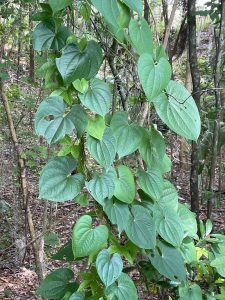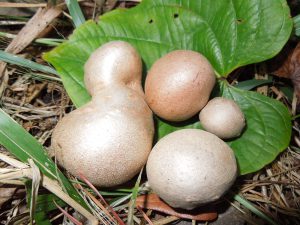
Vines grow like crazy in the heat and humidity of Florida. We have a lot of desirable native vine species like muscadine, with their tasty grapes, and morning glory, covered in brilliant purple and white flowers that help keep beach dunes intact. We also have annoying native vines like greenbriar (Smilax) with its spiky thorns, and the itch-inducing poison ivy. And then, we have invasive species like kudzu, Japanese climbing fern, and air potato, all of which cause ongoing problems to our native tree species.

The non-native invasive air potato vine (Discorea bulbifera) has wound its way throughout Florida, from pine forests and creek floodplains to backyards. Their heart-shaped leaves are most noticeable in the spring and fall, where they can take over large areas and choke out trees and shrubs. These wild yams can grow 8 inches in a single day! In the fall, the plant produces a potato-like tuber called a bulbil, which grows above ground on the vine. The bulbils drop in the winter and then produce new vines the following spring.

The vine’s growth has been uncontrolled or kept back by herbicide for years, until researchers in Florida discovered a biological control insect known as the air potato leaf beetle (Liloceris cheni). In the vine’s native Nepal and China, the beetle controls growth by surviving on the leaves of the air potato, its sole food source. After extensive study, the USDA approved the use of these beetles in Florida to control the air potato vine population here. UF IFAS Extension offices statewide have participated in these beetle release programs, providing thousands of beetles to homeowners and property owners seeking to manage the beetle using a chemical-free technique. Left alone, air potato vines can smother full-sized trees, blocking the sunlight and causing them to collapse under the weight of the intertwined vines.
From 2012-2015, beetles were able to reduce air potato vine coverage and bulbil density by 25-70% (depending on location and density of beetle population). Close to a million beetles were distributed through every county in the state, with field and community surveys indicating the beetles were reproducing and forming stable populations. The active beetle-production and distribution phase of the project ended in Fall 2022, but researchers with the Florida Department of Agriculture and Consumer Sciences (FDACS) are now looking at introduction of a related beetle species that eats the bulbils, and not the leaves, of the vine. After extensive testing, these beetles should be available for distribution in the next few years.
 8
8
